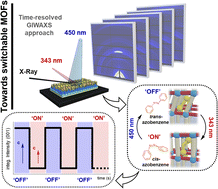Unraveling the timescale of the structural photo-response within oriented metal–organic framework films†
Abstract
Fundamental knowledge on the intrinsic timescale of structural transformations in photo-switchable metal–organic framework films is crucial to tune their switching performance and to facilitate their applicability as stimuli-responsive materials. In this work, for the first time, an integrated approach to study and quantify the temporal evolution of structural transformations is demonstrated on an epitaxially oriented DMOF-1-on-MOF film system comprising azobenzene in the DMOF-1 pores (DMOF-1/AB). We employed time-resolved Grazing Incidence Wide-Angle X-Ray Scattering measurements to track the structural response of the DMOF-1/AB film upon altering the length of the azobenzene molecule by photo-isomerization (trans-to-cis, 343 nm; cis-to-trans, 450 nm). Within seconds, the DMOF-1/AB response occurred fully reversible and over several switching cycles by cooperative photo-switching of the oriented DMOF-1/AB crystallites as confirmed further by infrared measurements. Our work thereby suggests a new avenue to elucidate the timescales and photo-switching characteristics in structurally responsive MOF film systems.



 Please wait while we load your content...
Please wait while we load your content...